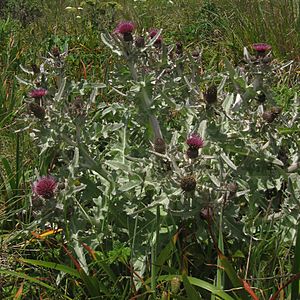Douglas' thistle facts for kids
Quick facts for kids Douglas' thistle |
|
|---|---|
 |
|
| Scientific classification | |
| Genus: |
Cirsium
|
| Species: |
douglasii
|
| Synonyms | |
|
Synonymy
Carduus undulatus var. douglasii (DC.) Greene
Cirsium breweri var. glutinosum Petr. Cirsium breweri var. wrangelii Petr. Cirsium breweri subsp. wrangelii Petr. Carduus breweri (A.Gray) Greene, syn of var. breweri Cirsium breweri (A.Gray) Jeps., syn of var. breweri Cirsium breweri var. canescens Petr., syn of var. breweri Cirsium breweri var. lanosissimum Petr., syn of var. breweri Cirsium douglasii var. canescens (Petr.) J.T.Howell, syn of var. breweri Cnicus breweri A.Gray, syn of var. breweri |
|
Cirsium douglasii is a type of thistle plant. It is commonly known as Douglas' thistle or California swamp thistle. This plant is native to the central coast and northern parts of California. You can also find it in nearby areas of southern Oregon and northwest Nevada. It prefers to grow in wet places, like swamps or damp fields.
What is Douglas' Thistle?
Douglas' thistle is a native plant that can be either a biennial or a short-lived perennial. A biennial plant lives for two years. A perennial plant lives for more than two years. This thistle can grow quite tall, reaching up to 2.5 metres (8.2 ft) high. Its stem often branches out and feels woolly.
Leaves and Stems
The longest leaves of the plant are found near its base. These leaves can be very long, up to 1 metre (3.3 ft) in length. They have a gray, woolly feel and sometimes have lobes or teeth along their edges. These leaves grow on a spiny stem-like part called a petiole.
Flowers and Seeds
The flowers of Douglas' thistle grow in a group called an inflorescence. This is a cluster of several flower heads surrounded by small leaves. Each flower head is about 3 centimetres (1.2 in) long. It is lined with spiny, purple-tipped parts called phyllaries.
Inside each head, you will find purple or white flowers. After the flowers bloom, the plant produces fruit. This fruit is a dark-colored seed, called an achene, which is about 2–4.5 millimetres (0.079–0.177 in) long. Each achene has a feathery top called a pappus, which can be up to 2 centimetres (0.79 in) long. The pappus helps the seeds float away in the wind.
Types of Douglas' Thistle
There are different types, or varieties, of Cirsium douglasii:
- Cirsium douglasii var. breweri - This variety is found in California, Oregon, and Nevada.
- Cirsium douglasii var. douglasii - This variety is found only in California.

